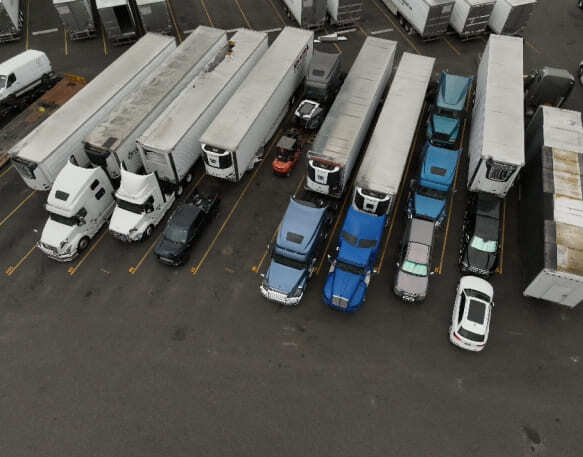
Securing your fleet: Best practices for fuel card security
Fuel cards for carriers offer convenience, cost savings, and detailed fuel tracking. However, without proper security measures, they can become a target for fraud and misuse, leading to financial losses and operational disruptions. This guide covers essential best practices for securing fuel cards, from creating clear usage policies and implementing spending controls to training drivers and leveraging real-time monitoring tools.
Fleet protection 101: How to keep your fuel cards secure
Fuel cards have become essential tools in modern fleet management. They make it easier to fuel up, cut down on paperwork, and give managers a clear view of fuel spending while helping to save money. With built-in tracking and spending controls, fuel cards offer more security than handing out company credit cards or reimbursing cash purchases.
But there is a catch: as useful as fuel cards are, they’re also a prime target for theft and fraud. A stolen or misused fuel card can lead to serious financial losses and headaches for any fleet. That’s why locking down fuel card security isn’t just a good idea—it’s a must.
In this guide, we’ll break down simple, effective ways to protect your fleet’s fuel cards. From setting clear policies and spending limits to training drivers and using real-time monitoring, these best practices will help your operations run smoothly and keep your budget intact.
Establish a secure fuel card policy
A solid fuel card security strategy starts with a clear, well-defined policy. Without clear guidelines, even the best security tools can fall short. A secure fuel card policy sets the foundation for how fuel cards can help prevent misuse and protect your fleet’s finances.
As for fuel card policy guidelines, start by outlining exactly who is authorized to use fuel cards, when they can be used, and where. Be specific—should drivers only fuel up during certain hours or at approved stations? Are there limits on what can be purchased beyond fuel? Clear rules eliminate confusion and make it easier to spot unusual activity. Fleet managers and drivers need to be fully aligned on these usage protocols to ensure smooth and secure operations.
Accountability is key to enforcing this policy. Drivers should be required to review and sign acknowledgment forms that detail proper fuel card usage. Acceptance statements and required signatures confirm that drivers understand the rules and reinforce the importance of following them. This step not only formalizes compliance but also fosters a culture of responsibility, reducing the risk of careless or intentional misuse.
Implement key fuel card controls
Once a secure fuel card policy is in place, the next step is to strengthen security with built-in controls that limit how, when, and where fuel cards can be used. Consider implementing the following controls to better protect your fleet’s fuel spending:
- Location restrictions: Limit fuel card usage to specific regions, such as designated ZIP codes or states, to prevent unauthorized purchases outside approved areas.
- Time-based restrictions: Set time-of-day and day-of-week limits to restrict fuel card usage to standard business hours, reducing the risk of misuse during off-hours.
- Spending limits: Establish daily or weekly spending caps that align with typical fuel consumption, to help prevent excess charges and flag unusual spending patterns.
- Merchant type controls: Restrict card usage to authorized fuel stations and lock purchases at non-fuel merchants to avoid unauthorized spending.
- Fuel grade restrictions: Limit purchases to approved fuel types, preventing overspending on unnecessary fuel grades.
- Tank capacity controls: Set fuel purchase limits that match each vehicle’s tank capacity, stopping drivers from fueling non-fleet vehicles or carrying excess fuel.
- Pay-at-pump only: Require drivers to use pay-at-pump options to eliminate the opportunity for in-store purchases.
Train drivers on secure card security
Proper driver training is a critical layer of defense in protecting fuel cards from theft and fraud. Since drivers handle these cards daily, equipping them with security best practices can significantly reduce the risk of misuse. Let’s go over some of the key areas to cover in training:
- Keep PINs private: Instruct drivers to keep their PIN numbers to themselves and never share them with anyone, including coworkers or supervisors. Sharing PINs compromises security and makes unauthorized transactions harder to detect.
- Inspect card readers: Train drivers to examine card readers for signs of tampering, such as loose parts, bulky attachments, or anything that seems out of place. Catching a suspicious device early can prevent card skimming.
- Choose safe fueling locations: Encourage drivers to fuel up at pumps near attendants, store entrances, or in well-lit, high-traffic areas. These locations are typically monitored and are less likely to have skimming devices installed.
- Shield the keypad: Remind drivers to cover the keypad with their hand or body when entering their PIN to protect against hidden cameras or other devices designed to capture sensitive information.
Use fuel card monitoring tools
Implementing fuel card monitoring tools adds another critical layer of protection to your fleet’s security strategy. These tools provide real-time insights into fuel card usage, allowing fleet managers to quickly detect and respond to suspicious activity.
- Real-time monitoring: Use real-time data and reporting tools to actively track fuel card transactions. Monitoring purchases as they happen makes it easier to spot irregularities—like multiple transactions in a short time or purchases in unauthorized locations—and take immediate action.
- Fraud alerts: Set up automated alerts for unusual activity, such as transactions that exceed spending limits, occur outside approved locations, or happen during off-hours. Instant notifications allow fleet managers to quickly investigate and stop fraudulent activity.
- Driver accountability: Make sure drivers understand that their fuel card usage is monitored and that they play a vital role in maintaining security. Being open about having these monitoring systems in place encourages responsible behavior and reinforces the importance of following company policies.
Adapt controls to fleet needs
Fuel card security isn’t a one-size-fits-all solution. To maximize protection and efficiency, it’s important to adapt controls to fit the unique needs of your fleet. Customizing these settings ensures that security measures support operations rather than hinder them.
- Customization by vehicle type: Tailor fuel card controls based on the specific vehicle. Larger trucks with lower fuel efficiency may require higher spending limits or access to diesel fuel, while smaller, more fuel-efficient vehicles might need stricter spending caps. Aligning controls with each vehicle’s fuel type, tank size, and usage patterns helps prevent misuse and keeps fuel spending in check.
- Flexibility for seasonal demands: Fleets often experience fluctuations in activity throughout the year. During peak seasons or high-demand periods, adjust controls to allow for increased fueling needs without compromising security. Temporary increases in spending limits or expanded location access can support operational demands while still protecting your business.
- Regular review and adjustments: Fleet operations are constantly evolving, and fuel card controls should evolve too. Keep an eye on spending patterns, vehicle usage, and fuel card reports to identify areas where controls need to be tightened or adjusted.
Responding to fuel card fraud
Even with strong security measures in place, fuel card fraud can still happen to anyone. That’s why having a clear and immediate response plan is essential to minimizing damage and preventing future incidents. A swift, organized reaction can make all the difference in protecting your fleet’s finances.
The first step is to establish a well-defined action plan for handling suspected fraud. This plan should outline the process for quickly canceling compromised cards, freezing accounts if necessary, and reporting suspicious transactions for investigation. Taking immediate action helps stop unauthorized charges in their tracks and limits financial losses. Fleet managers and drivers should know exactly who to contact and what steps to follow when fraud is suspected, ensuring a prompt and coordinated response.
In addition to having an internal response plan, it’s crucial to collaborate closely with your fuel card provider. Many providers offer fraud detection tools and dedicated support that can help fleets manage and resolve fraudulent activity. Leveraging their expertise and security resources can strengthen your fraud prevention strategy and streamline the resolution process if issues arise.
Fuel card security: A smart investment in your fleet’s future
Securing fuel cards is more than just preventing fraud; it’s about protecting your fleet’s financial health and keeping your business moving forward. By establishing clear usage policies, implementing strong controls, training drivers on secure practices, and leveraging real-time monitoring tools, fleet managers can create a solid defense against theft and misuse. Now is the time to put these best practices into action and strengthen your fleet’s protection.
FAQs
A few things you might be asking yourself
Fuel card security is more important than you might think. Without the right safeguards, fuel cards can easily be misused or even stolen, leading to unauthorized purchases and financial losses. But it’s not just about preventing fraud—it’s about keeping your fleet running smoothly. With proper policies, spending controls, and driver training in place, you can protect your budget, simplify expense tracking, and avoid the headaches that come with fraud. Strong fuel card security means peace of mind for fleet managers and drivers alike.
Stopping fuel card fraud starts with being proactive. Set clear rules about who can use the cards, where they can be used, and how much can be spent. Put controls in place—like location limits, spending caps, and merchant restrictions—to block suspicious transactions. Use real-time monitoring tools to catch anything unusual, and make sure drivers are trained on safe card practices, like keeping PINs private and spotting tampered card readers. Partnering with a trusted fuel card provider like DAT also adds an extra layer of protection.
Drivers are on the front lines when it comes to fuel card use, so their actions can make or break your security strategy. Teaching them to keep their PINs private, check for tampered card readers, and fuel up in safe, well-lit areas goes a long way in preventing fraud. It’s also a good idea to have them sign off on fuel card policies so they know you’re serious about security. When drivers are informed and accountable, they’re much more likely to spot and avoid potential threats.
Fuel card controls aren’t a set-it-and-forget-it deal. It’s smart to review them regularly (at least every few months) or anytime your operations change. Maybe your team grows, fuel prices shift, or seasonal demands increase. Whatever the case, adjusting controls like spending limits and location restrictions keeps your security strategy current. Keeping a close eye on transaction reports can also help you spot trends and make necessary tweaks.
If you suspect fuel card fraud, don’t wait—take action right away. Cancel the compromised card, freeze the account, and report the suspicious activity to your fuel card provider. Most providers can assist with investigating and resolving fraud cases. It’s also important to review recent transactions for other unusual activity and tighten your fuel card controls to prevent future incidents. Acting quickly can help protect your fleet from greater financial losses down the road.




